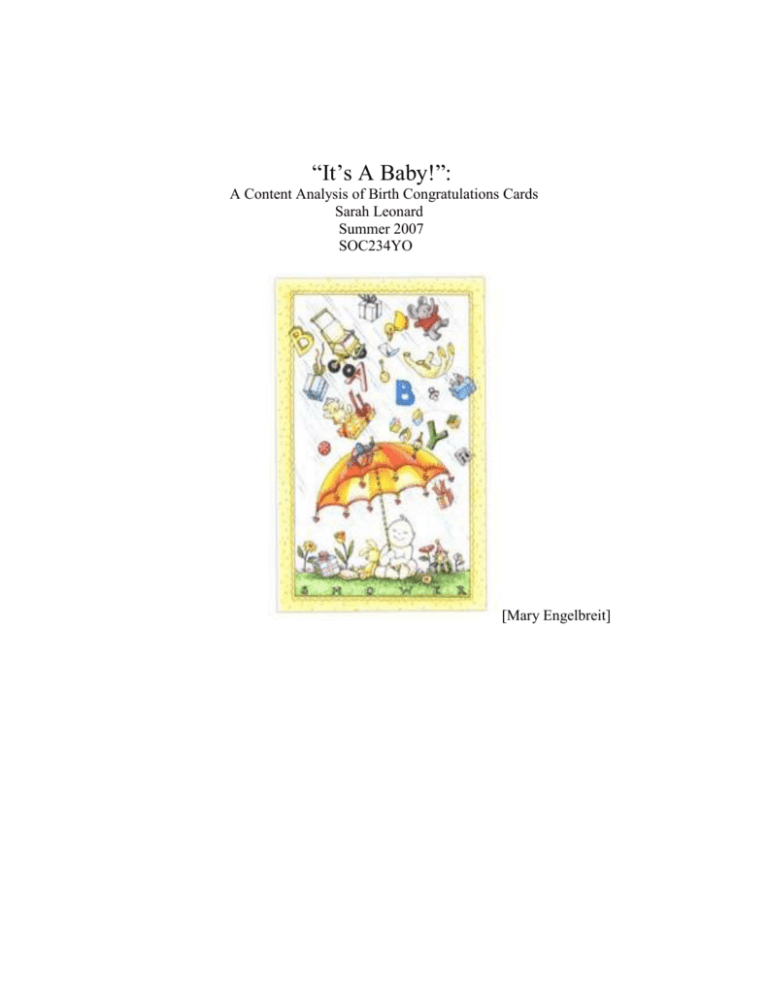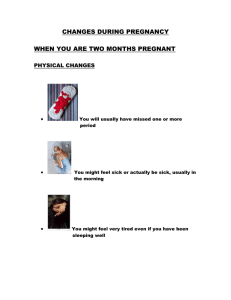
“It’s A Baby!”:
A Content Analysis of Birth Congratulations Cards
Sarah Leonard
Summer 2007
SOC234YO
[Mary Engelbreit]
INTRODUCTION
From a very early age, society shapes who we are and who we will become. All
we know about the structure of society, its rules and regulations for what is and is not
acceptable, we learned from watching and through interactions with family, friends,
school, the media, and other agents of socialization. Sociologists agree, “the family is by
far the most significant agent of socialization” (Lindsey, 2005, 61). In the interactions of
the family with the baby, the foundation is set for its personality, and its emerging gender
identity. “Newborn girls and boys don’t behave differently; they’re all simply babies”
(Walters, 2005, 334).
The issue that emerges is exactly how early in the child’s life do these gendered
messages begin to be conveyed? Through a content analysis of Birth Congratulations
Cards similar, but more limited in scope, to those conducted by Judith S. Bridges (1993)
and Lynda R. Willer (2001), I examined how these gender-role expectations are
“embedded” within such cards. This research examines how these greeting cards convey
gender stereotypes of infants. Through content analysis of 29 birth congratulations cards
designated for “Baby Girl,” “Baby Boy,” and the combined categories of “Baby/New
Baby/Baby Shower/Parents-To-Be,” this research examines the subtle and overt gender
differences represented.
What is communicated through these cards, while not for the baby directly, does
affect the baby. The messages conveyed reinforce the perceptions and expectations that
boys and girls are different and should be treated as such (Willer, 2005, 344).
DATA AND METHODS
Though most of the cards I viewed were by Hallmark, I chose not to go
specifically to a Hallmark specialty store. As, “over 90 percent of the consumers of
greeting cards are women” (Willer, 2005, 336) and women do more domestic chores than
men, I concluded that a specialty shop would not be a proper choice for two reasons.
First, while women might be more willing to shop at specialty stores for cards than men,
given the burden of housework they might be more crunched for time. Second, the men
who did choose or need to do card shopping, given hegemonic masculinity norms of
toughness and anti-femininity, may not feel comfortable in specialty card shops. For
these reasons, I chose a Barnes & Noble location and a Genaurdi’s food store, where men
and women can multi-task in comfortable and/or convenient surroundings. While both of
these locations are in suburban, predominately middle class areas, they serve a client base
of variant incomes, genders, and races.
While I made efforts to view cards informally while both deciding where to do
my research and after at another Barnes & Noble location, a Target, a CVS, (all within
the same geographic area) and online, I formally coded 29 cards at two locations during
to specific outings. The cards chosen were a convenience sample, picked from what was
available at two locations, however they are not equally distributed across the three card
categories. Of 15 cards reviewed at the Genaurdi’s food store, 3 cards each were
designated for Boys and Girls and 9 cards were for Baby/New Baby/Parents-To-Be. At
Barnes & Noble, of 14 cards reviewed, 8 cards were for Baby/Baby Shower and again 3
cards each were present for Boys and Girls. Throughout, I use the terms “Baby
card/category” interchangeably with “gender-neutral card/category.”
LITERATURE REVIEW
In 1993, Judith S. Bridges published her study, Pink Or Blue, examining gender
stereotypes as present in “the visual images and verbal messages present in birth
congratulations cards” (Bridges, 193). In 2001, Lynda R. Willer expanded on Bridges
work. Instead of using only cards tagged for boys or for girls, she also included genderneutral cards “as an informal control group [to] presumably highlight the anticipated
differences between cards intended for girl babies and [those] for boy babies” (Willer,
2005, 339).
Considering “research [that] shows about 30 percent of all prospective parents are
opting to be surprised” (The Citizen, 2007) about the sex of their baby, greeting card
companies are taking note of this trend, and researchers are wise to it as well. At Barnes
& Noble, non-gendered cards outnumbered cards for both baby girls and baby boys
combined. However, Willer’s sample was a convenience sample while Bridges was a
random sample taking into consideration the different race, ethnic, and socio-economic
positions of potential greeting card consumers. Therefore, Willer’s work cannot be
generalized past her individual study.
Both researchers wanted to know if the congratulations cards for baby boys and
baby girls were qualitatively different and if those differences were consistent with
traditional gender stereotypes (Bridges, 1993, 195). While Bridges made no hypothesis,
her “content analysis revealed several differences between girl and boy cards” (Bridges,
1993, 193). Willer too concluded that her “results suggest that ‘gendered’ messages are
being sent…”(Willer, 2005, 344).
RESULTS
Outside of the “Pink or Blue” dichotomy, most of the cards I examined appeared
harmless at a glance. However, as the cards are broken down, a few noticeable
differences appear both in the non-verbal and verbal characteristics:
Non-verbal:
· Only one card, for a boy, showed “Sports Equipment” (bats, balls, etc.).
· Three cards, all for boys, showed “Transportation” (planes, trains, boats,
rockets, etc).
· Twelve of the 17 gender-neutral cards showed some type of animal(s)/stuffed
animal(s) and the boys’ and girls’ cards were also equally likely to display them as well,
3 and 3.
· All gender-neutral cards displayed either a mix of colors, predominately white,
or predominately another color besides blue or pink.
· The colors of boys’ cards were equally likely to be predominately Mixed/Other
as they were to be predominately Blue. However, girls’ cards were 5 to 1 in favor of Pink
and none were dominated by Blue.
Verbal:
· Two cards, 1 for a boy and 1 for a girl, used the word “cute.” No gender-neutral
cards used this word.
· Hearts and flowers were used on either baby girl cards or gender-neutral cards,
but not on baby boy cards.
· Baby cards were equally likely, 4 and 4, to use the word “sweet” as girl cards;
boy cards did not use this word. However, boy cards were equally likely, 1 and 1, to use
the word “precious” as baby cards; girl cards did not use this word.
Good description here, but it is a bit unwieldy. It is best to use a table to show the
information.
The strengths of this research include the equal numbers of Girl and Boy cards
selected at both locations, the inclusion of “gender-neutral” baby cards as a “control
group” (as included in Willer’s study), and coding for the dominant colors of the greeting
card envelopes (as included in Bridges’ study).
As my research was more limited than previous research, the weaknesses of my
data collection process include the limited number of cards selected; the disproportionate
number of gender-neutral cards to boy/girl cards; limited number of verbal and nonverbal characteristics coded for; neglect in counting the number of words in the message,
coding the color of the message itself, properly noting geometric shapes (circles and
triangles) and plaids/stripes, taking into account the style of the message (prose versus
rhyme), and differentiating between the dominate color on the cover versus the dominate
color on the inside (I only looked at the most frequent color overall); and failure to note
the active versus passive manner of any life-like characters.
My formal data is “tainted” in light of informal data that I also acquired. I
formally coded 29 cards at two locations during to specific outings. However, over
additional trips to other stores and via the Internet, I informally reviewed an additional
40+ cards. A few of these additional cards provided some interesting contrast.
A number of boys and girls cards were designed to be identical to each other
(wording and image), only the girl’s card in pink and the boy’s card in blue or green.
Additionally, many boys’ cards displayed a sleeping or lounging baby. However, when
babies (or baby animals) were shown doing age-inappropriate actions, these cards were
likely to show boys. (As pictured below.)
Additionally, while the cards I viewed in person were equally likely to express
positive emotions over the child’s birth, two cards (1 from a book and one through the
internet) hinted at ‘disappointment’ over the baby being a girl. The card below, at left, is
of a child in a frilly bonnet and reads, “I’m a victim of circumstance.” At right, a card
from the humor greeting card company, NobleWorks, tells of a circumcision gone wrong.
These cards, which were not matched by any delegated for boys, suggest that a baby girl
is an accident or a victim that we should feel sorry for. While these cards were rare in my
research, that these cards have remained over the last fifty years means that their
messages are still a part of our culture.
CONCLUSIONS
The most surprising finding overall, was the gender-neutrality of religious baby
cards. Consistent with Willer’s findings, when comparing “Baby” cards, those with
religious messages on them were consistently the most gender ambiguous. From my
personal bias, I assumed that cards with a religious message would also stick firmly to
traditional male/female gender expectations. For Willer, who also concluded in her
research that gender-neutral cards were most similar to girl cards, this brought up an
interesting observation, “that those buyers wanting not to send a gendered message are
actually forced into sending either a religious message or one that approximates the
message sent to welcome little girls” (2005, 354). Still, the trend towards more genderneutral birth congratulations cards is notable. In some cases, thought, even when the baby
pictured is gender-neutral, the mother and father are hyper-feminine and hypermasculine.
Further analysis of interest would be coding for price to examine whether there is
a correlation between the price of the card and the level of gender-neutral the card has.
Egalitarian marriages are associated with women having their own careers. As women
break from traditional gender roles and venture out into the workplace, they may garner
more decision and domestic chore sharing with their husbands. The implications of
greater gender-neutrality in higher priced cards might be the perpetuation of traditional
gender roles amongst the lower social classes.
In my research, while difference did appear between the birth congratulations
cards I examined, very few sent up overt red flags regarding the perpetuation of gendered
stereotypes, which here in lies the problem. The messages sent by all categories of baby
greeting cards were subtle. I found that, aside from the pink or blue distinction, there is
decreasing differentiation between boys and girls cards; though, the use of these colors
represents more than what meets the eye. Blue connotes all the things the baby boy will
eventually do, even if these things are not pictured or expressed on the card, and pink
connotes all the things the baby girl will eventually do; in society’s eyes, these pursuits
are specifically masculine or feminine, respectively. Knowing this, their parents will
consciously or unconsciously begin socializing them into their traditional gender roles. In
conclusion, while the presence of gender-neutral cards is a step forwards, the persistent of
the “pink or blue” dichotomy perpetuates traditional gender roles.
REFERENCES
Baby – Product Catalog. Retrieved August 2, 2007 from
http://shop.maryengelbreit.com/SearchResult.aspx?CategoryID=83
Bridges, J. S. (1993). Pink or blue: Gender-stereotypic perceptions of infants as conveyed
by birth congratulations cards. Psychology of Women Quarterly, 17 (2), 193-205.
Lindsey, L. L. (2005). Gender roles: A sociological perspective (2th ed.). Pearson
Prentice Hall
NobleWorks Greeting Cards – Baby Cards!. Retrieved August 2, 2007 from
http://www.nobleworkscards.com/c-5-baby.aspx
NobleWorks Presents: The Horny Rabbit – We Three Mohels. Retrieved August 2, 2007
from http://www.nobleworkscards.com/pc-1564-5-we-three-mohels.aspx
Stern, E. S. (1988). The very best from Hallmark: greeting cards through the years. New
York: Harry N. Abrams, Inc., Publishers.
The Citizen. (2007, June 2). Oh, Baby!; Tips for celebrating parenting milestones. Prince
George Citizen (British Columbia). Retrieved July 13, 2007 from Lexis-Nexis
database.
The Mary Engelbreit Store – Baby Shower Card – Detail. Retrieved August 2, 2007 from
http://shop.maryengelbreit.com/detail.aspx?ID=4757
Walters, K. & Brody, M. (Eds.). (2005). What’s language got to do with it?. New
York/London: W. W. Norton & Company.
Willer, L. R. (2005). Welcome to Your World, Baby. In K. Walters & M. Brody (Eds.),
What’s language got to do with it? (pp. 336-346). New York/London: W. W.
Norton & Company. (Original work published 2001).
Sarah,
This is extremely well done! You do an excellent job organizing the ideas, tying
the findings to theories and course concepts, and providing suggestions for further
analysis. You also consult a thorough set of academic resources. I do wish the
presentation of findings were more clearly summarized in a table though.
It has been a pleasure to have you in class. Though we will miss you in
Honors,you are definitely ready to do well at Temple next year! Let me know how
everything goes. Enjoy the rest of your summer.
94/A








